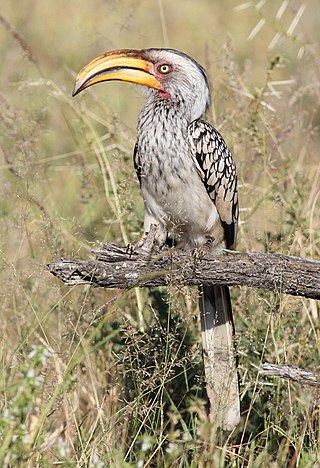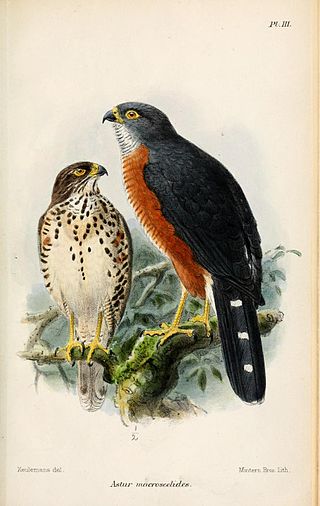
Hawks are birds of prey of the family Accipitridae. They are very widely distributed and are found on all continents except Antarctica.

The dark chanting goshawk is a bird of prey in the family Accipitridae which is found across much of sub-Saharan Africa and southern Arabia, with an isolated and declining population in southern Morocco.

The lizard buzzard, or lizard hawk, is a bird of prey in the family Accipitridae. It is the only species placed in the genus Kaupifalco. It is native to Sub-Saharan Africa. Despite its name, it may be more closely related to the Accipiter hawks than the Buteo buzzards.

The African harrier-hawk, harrier hawk or gymnogene is a bird of prey. It is about 60–66 centimetres (24–26 in) in length. It breeds in most of Africa south of the Sahara. The only other member of the genus is the allopatric Madagascar harrier-hawk.

The southern yellow-billed hornbill is a hornbill found in southern Africa. Yellow-billed hornbills feed mainly on the ground, where they forage for seeds, small insects, spiders and scorpions. This hornbill species is a common and widespread resident of dry thornveldt and broad-leafed woodlands. They can often be seen along roads and water courses.

The ring-necked dove, also known as the Cape turtle dove or half-collared dove, is a widespread and often abundant dove species in East and southern Africa. It is a mostly sedentary bird, found in a variety of open habitats. Within range, its penetrating and rhythmic, three-syllabled crooning is a familiar sound at any time of the year. Its name is derived from the semi-collar of black feathers on the lower nape, a feature shared with a number of Streptopelia species. Like all doves, they depend on surface water. They congregate in large flocks at waterholes in dry regions to drink and bathe.

The bateleur, also known as the bateleur eagle, is a medium-sized eagle in the family Accipitridae. It is often considered a relative of the snake eagles and, like them, it is classified within the subfamily Circaetinae. It is the only member of the genus Terathopius and may be the origin of the "Zimbabwe Bird", the national emblem of Zimbabwe. Adult bateleurs are generally black in colour with a chestnut colour on the mantle as well as also on the rump and tail. Adults also have gray patches about the leading edges of the wings with bright red on their cere and their feet. Adults also show white greater coverts, contrasting with black remiges in males, gray patches on the underwing primaries and black wingtips. The juvenile bateleur is quite different, being largely drab brown with a bit of paler feather scaling. All bateleurs have extremely large heads for their size, rather small bills, large feet, relatively short legs, long, bow-like wings and uniquely short tails, which are much smaller still on adults compared to juvenile birds.

The pale chanting goshawk is a bird of prey in the family Accipitridae. This hawk breeds in southern Africa and is a resident species of dry, open semi-desert with 75 cm or less annual rainfall. It is commonly seen perched on roadside telephone poles.

The eastern (pale) chanting goshawk, or Somali chanting goshawk, is a bird of prey of East Africa.

The black sparrowhawk, sometimes known as the black goshawk or great sparrowhawk, is a bird of prey belonging to the family Accipitridae. It was formerly placed in the genus Accipiter. It occurs mainly in forest and non-desert areas south of the Sahara, particularly where there are large trees suitable for nesting; favored habitat includes suburban and human-altered landscapes. It preys predominantly on birds of moderate size, such as pigeons and doves, in suburban areas.

The little sparrowhawk is a species of Afrotropical bird of prey in the family Accipitridae. It was formerly placed in the genus Accipiter. It is the smallest member of the genus Tachyspiza and forms a superspecies with the red-thighed sparrowhawk.

The African goshawk is an African species of bird of prey in the genus Aerospiza. This species was formerly placed in the genus Accipiter.

Ayres's hawk-eagle, also referred to as Ayres' eagle, is a medium-sized bird of prey in the family Accipitridae. It is native to African woodlands. Its name honors South African ornithologist Thomas Ayres.

The African cuckoo or African grey cuckoo is a species of cuckoo in the family Cuculidae. It is found in Sub-Saharan Africa where it migrates within the continent, generally arriving and breeding in any one locality during the rainy season. A fairly common bird, the International Union for Conservation of Nature has rated its conservation status as being of "least concern".

The Senegal batis is a species of small passerine bird in the wattle-eyes family, Platysteiridae. It occurs in western Africa where it is found in dry savanna and subtropical or tropical dry shrubland. It was originally given the binomial name Muscicapa senegalensis by Carl Linnaeus in 1766.

The black-backed puffback is a species of passerine bird in the family Malaconotidae. They are common to fairly common sedentary bushshrikes in various wooded habitats in Africa south of the equator. They restlessly move about singly, in pairs or family groups, and generally frequent tree canopies. Like others of its genus, the males puff out the loose rump and lower back feathers in display, to assume a remarkable ball-like appearance. They draw attention to themselves by their varied repertoire of whistling, clicking and rasping sounds. Their specific name cubla, originated with Francois Levaillant, who derived it from a native southern African name, where the "c" is an onomatopoeic click sound. None of the other five puffback species occur in southern Africa.

The grey-headed bushshrike, colloquially known as the ghostbird, is a species of passerine bird in the family Malaconotidae. It is widespread throughout sub-Saharan Africa, although relatively absent in Central Africa and the interior of southern Africa. It is the most widespread species of its genus, which consists of large bushshrikes with massive bills and mournful hooting calls. It occurs sparsely in a range of wooded habitats, though typically in denser vegetation within dry or moist savannah. The monogamous pairs occupy woodland with sufficient cover. They are sedentary, but will undertake limited post-breeding movements.

The red-chested goshawk is a medium-size hawk of West Africa. It is often considered conspecific with the African goshawk. This species was formerly placed in the genus Accipiter.
Goshawk may refer to several species of birds of prey, mainly in the genus Accipiter:

The Eurasian goshawk is a species of medium-large bird of prey in the family Accipitridae, a family which also includes other extant diurnal raptors, such as eagles, buzzards and harriers. It was formerly placed in the genus Accipiter. It is a widespread species that inhabits many of the temperate parts of the Eurasia. Except in a small portion of southern Asia, it is the only species of "goshawk" in its range and it is thus often referred to, both officially and unofficially, as simply goshawk. It is mainly resident, but birds from colder regions migrate south for the winter. As of 2023, goshawks found in North America are no longer considered be conspecific, but are now designated as the American goshawk.




















